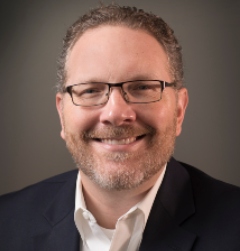Twenty years of research and collaboration, culminating in SpectrumX, featured in keynote address at GRCon 22

By Christina Clark
On Thursday, September 30, SpectrumX Center Director Nick Laneman gave a keynote address at GRCon 22 in Washington D.C. Laneman concurrently co-directs the Wireless Institute in the College of Engineering and is a professor in the Department of Electrical Engineering at the University of Notre Dame.
GRCon 22 is hosted by GNU Radio project. GNU Radio is “a free and open-source software development toolkit that provides signal processing blocks to implement software radios,” according to its website. It is utilized by researchers, industry, government, hobbyist, and academic stakeholders alike.
During his address, Laneman reflected on applying and developing several software-defined radio (SDR) platforms as foundational tools in research, teaching and collaboration activities that have been pursued by the Wireless Institute and researchers at the University of Notre Dame over the past 20 years. Laneman also spoke about the inspiring colleagues he met during his own studies at Washington University in St. Louis and the Massachusetts Institute of Technology, and how these experiences have carried through to his research career combining communications system design and SDR implementations.
He was “motivated by a deep desire to connect theory and real-world prototyping,” according to his keynote abstract. This, in turn, led to his efforts in lowering the barrier of entry for students to bring them into the fields of electrical engineering generally and wireless systems specifically.
SpectrumX was introduced in the latter half of Laneman’s keynote speech. He spoke about the center’s founding in 2021 and mission. SpectrumX, funded by the U.S. National Science Foundation (NSF) with a $25 million grant over five years, is part of the NSF’s Spectrum Innovation Initiative.
“The Center is not your traditional NSF grant: It’s a large-scale national hub,” Laneman said. “We are doing research, but there is a significant emphasis on education and workforce development. There is also significant emphasis on collaboration and policy outreach. We are doing a lot of interfacing and interacting across the spectrum ecosystem.”
Laneman noted other hubs, like the National Spectrum Consortium, funded by the U.S. Department of Defense, have also recently been launched.
SpectrumX is set to be the connection between industry, government, and education stakeholders in the field, according to Laneman.
GRCon 22 also featured Tony Beasley, Director of the National Radio Astronomy Observatory (NRAO) as the Wednesday Keynote speaker. Beasley is a Research Partner within SpectrumX, with the NRAO being a key partner institution to the center.
Beasley spoke about satellite constellations, radio astronomy and the NRAO’s role providing telescopes, research, and programming in the field. He also spoke about the reasons why the NRAO and researchers like himself continue to do this work. He introduced the different telescopes and observatories the NRAO utilizes, including the Karl G. Jansky Very Large Array (VLA) Telescope and the Very Long Baseline Array.
Beasley showed a video of the VLA as the dishes moved their focus throughout time while experiencing weather, airplanes overhead, and other types of potential signal interference.
“It gives you a sense of what we deal with in the real world,” Beasley said. “Amongst all of that, we are still doing our astronomy. In some sense, that’s what the interference of these constellations is going to look like. We are going to have to continue developing technologies and developing ways of processing the data to be immune to some of the effects of these events,” he said.
See Nick Laneman’s keynote speech: here.
See Tony Beasley’s keynote speech: here.
About SpectrumX
SpectrumX is funded by the National Science Foundation (NSF) as part of its Spectrum Innovation Initiative, under grant number AST 21-32700. SpectrumX is the world’s largest academic hub where all radio spectrum stakeholders can innovate, collaborate, and contribute to maximizing social welfare of this precious resource.To learn more about SpectrumX, please visit spectrumx.org.
Contact:
Christina Clark, Research Communications Specialist
SpectrumX / Notre Dame Research / University of Notre Dame
cclark26@nd.edu / 574.631.2665
spectrumx.org